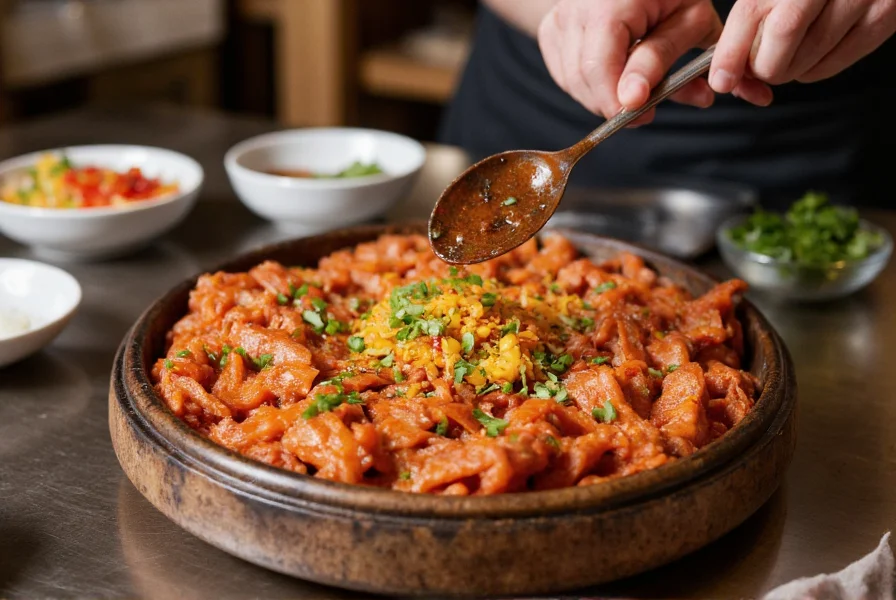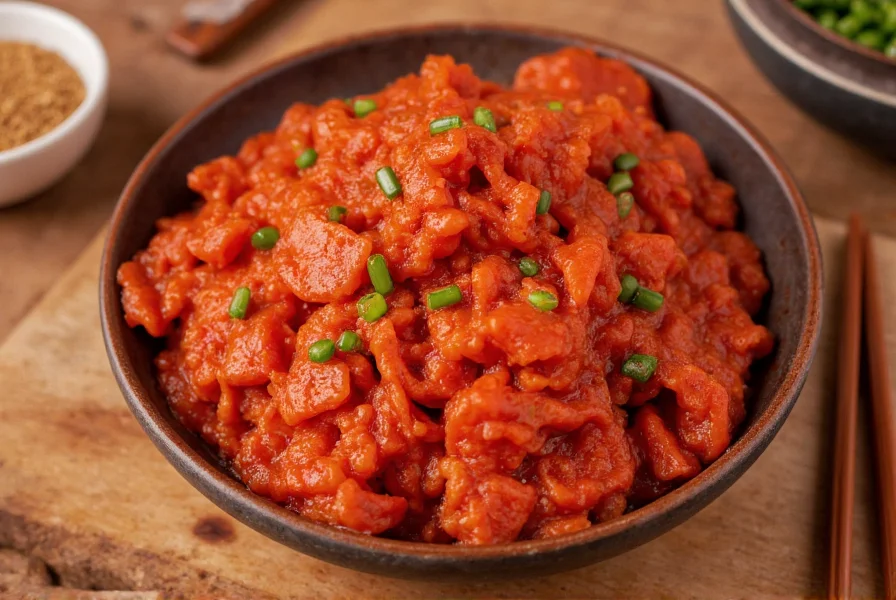Gochujang has been a cornerstone of Korean cuisine for centuries, evolving from royal court kitchens to everyday pantry staples. This versatile fermented paste brings depth and complexity to marinades, sauces, and stews, making it indispensable for authentic Korean cooking. Understanding its composition, flavor profile, and proper usage unlocks endless culinary possibilities beyond traditional applications.
Historical Roots and Cultural Significance
Originating during Korea's Joseon Dynasty (1392-1910), gochujang evolved from earlier fermented soybean pastes after chili peppers were introduced to Korea through trade routes in the 16th century. Initially considered a luxury item for royalty and nobility, this Korean red pepper paste gradually became accessible to common households by the 19th century. The traditional production method involves fermenting ingredients in large earthenware pots called onggi, which allows for natural temperature regulation during the months-long fermentation process.
UNESCO recognized Korean jang (fermented condiments including gochujang) as an Intangible Cultural Heritage in 2015, highlighting its cultural importance. Unlike quick-processed modern versions, authentic gochujang develops complex flavors through natural fermentation, creating distinctive taste compounds that cannot be replicated through artificial means.
Ingredients and Traditional Production Process
The magic of genuine Korean chili paste comes from just four essential ingredients:
| Ingredient | Role in Gochujang | Traditional Source |
|---|---|---|
| Red chili peppers (gochugaru) | Provides heat and vibrant color | Sun-dried Korean red peppers |
| Glutinous rice (chapssal) | Creates sweetness through natural fermentation | Steamed short-grain sticky rice |
| Meju powder (fermented soybeans) | Contributes umami and depth | Traditional Korean fermented soybean blocks |
| Sea salt | Preserves and enhances fermentation | Korean solar-evaporated sea salt |
The traditional production begins with steaming glutinous rice, which is then mixed with meju powder (ground fermented soybeans) and chili powder. This mixture is formed into blocks called chongkukjang and placed in onggi pots with brine. The fermentation process lasts 6-12 months, during which natural enzymes break down starches into sugars and proteins into amino acids, creating gochujang's signature complex flavor.
Flavor Profile and Sensory Characteristics
Authentic Korean gochujang offers a sophisticated balance that distinguishes it from other chili pastes:
- Heat level: Moderate spiciness (1,500-10,000 Scoville units) with gradual warmth rather than immediate burn
- Sweetness: Natural sugars from fermented rice provide subtle sweetness without added sugar
- Umami: Deep savory notes from fermented soybeans create rich mouthfeel
- Texture: Smooth but slightly grainy consistency, thicker than sriracha but pourable
- Aroma: Earthy, slightly smoky fragrance with fermented complexity
This complexity makes gochujang versatile for both traditional Korean recipes and fusion cooking. Unlike gochugaru (Korean chili flakes), which provides pure heat, gochujang contributes multiple flavor dimensions that enhance rather than overwhelm dishes.
Understanding Gochujang Varieties
While traditional gochujang follows a standard recipe, modern variations cater to different preferences and dietary needs:
- Regular gochujang: Standard version with balanced heat and sweetness
- Mild gochujang: Reduced chili content for less heat while maintaining flavor
- Sweetened gochujang: Additional sweeteners for dishes requiring more sugar
- Organic gochujang: Made with certified organic ingredients
- Sugar-free gochujang: Alternative sweeteners for dietary restrictions
- Fresh gochujang: Refrigerated versions with minimal preservatives
When selecting authentic Korean chili paste, check the ingredient list for minimal additives. Traditional varieties contain only the four core ingredients, while commercial versions may include sweeteners, preservatives, or thickeners that alter the flavor profile.
Culinary Applications and Usage Tips
Gochujang's versatility extends far beyond traditional Korean cooking. Professional chefs and home cooks use it to enhance various dishes:
- Marinades: Combine with garlic, sesame oil, and soy sauce for meats
- Stir-fry sauces: Mix with rice vinegar and honey for quick glazes
- Stews and soups: Essential for tteokbokki, budae jjigae, and kimchi jjigae
- Dipping sauces: Blend with mayonnaise or yogurt for sandwiches
- Grill glazes: Brush on proteins during final cooking minutes
- Vegetable dressings: Whisk with olive oil and rice vinegar
When cooking with gochujang, remember that heat intensifies its spiciness while prolonged cooking mellows the heat and deepens flavors. For best results in sauces, bloom the paste in a small amount of oil before adding liquids to maximize flavor extraction. Start with 1-2 tablespoons per serving and adjust to taste, as concentrations vary between brands.

Storage and Shelf Life Guidelines
Proper storage maintains gochujang's quality and extends its shelf life:
- Unopened containers: Store in cool, dark pantry for 1-2 years
- Opened containers: Refrigerate immediately in airtight container
- Surface mold: Scoop off small mold spots and stir; discard if extensive
- Quality indicators: Darkening color and intensified flavor are normal
- Freezing: Portion into ice cube trays for long-term storage
Traditional fermented gochujang actually improves with age when properly stored, developing more complex flavors over time. Commercial versions with preservatives maintain consistent flavor but don't develop the same depth through aging.
Substitutes and Comparisons
When authentic Korean chili paste isn't available, these alternatives can work in a pinch:
- Doubanjiang: Chinese fermented broad bean paste (less sweet, different flavor profile)
- Sriracha + ketchup: 1:1 ratio for quick substitute (lacks depth of fermentation)
- Harissa + miso: North African chili paste with white miso for umami
- Chipotle peppers + tomato paste: Smoky alternative for Western palates
Understanding the differences between gochujang and similar condiments helps select appropriate substitutes:
- Gochujang vs. Gochugaru: Paste versus flakes - gochujang contains fermented elements while gochugaru is pure chili powder
- Gochujang vs. Doenjang: Doenjang is soybean paste without chili, more intense umami
- Gochujang vs. Sriracha: Gochujang is thicker, sweeter, and more complex with fermented depth
Nutritional Profile and Health Considerations
Two tablespoons (30g) of traditional gochujang typically contains:
- Calories: 30-40
- Carbohydrates: 7g (including 1g fiber)
- Protein: 1-2g
- Fat: 0g
- Sodium: 200-300mg
The fermentation process creates beneficial compounds including:
- Natural probiotics supporting gut health
- Antioxidants from chili peppers
- B-vitamins produced during fermentation
- Capasaicin with potential metabolic benefits
While generally healthy in moderation, commercial varieties may contain added sugars and preservatives. For dietary restrictions, check labels for gluten content (some brands use wheat) and verify against specific dietary needs.
Finding Quality Gochujang
When selecting authentic Korean chili paste, consider these factors:
- Look for minimal ingredients: chili peppers, rice, soybeans, salt
- Check for Korean manufacturing labels (made in Korea)
- Traditional brands often feature Korean writing on packaging
- Refrigerated sections typically contain fresher, less processed varieties
- Read reviews focusing on flavor complexity rather than just heat level
Asian grocery stores usually offer the widest selection of authentic brands at better prices than mainstream supermarkets. Online retailers specializing in Korean ingredients provide access to premium artisanal varieties that may not be available locally.
Frequently Asked Questions
What is the difference between gochujang and regular hot sauce?
Gochujang differs from regular hot sauce through its complex fermentation process using rice and soybeans, resulting in a balanced flavor profile that combines spicy heat with natural sweetness and deep umami notes. Most hot sauces focus primarily on heat with vinegar-based preservation, while gochujang develops complex flavors through months of natural fermentation.
Can I make gochujang at home?
Yes, you can make homemade gochujang, though the traditional process requires significant time and specific ingredients. Authentic preparation involves fermenting a mixture of Korean red chili powder, steamed glutinous rice, and fermented soybean powder in brine for 6-12 months. Modern simplified versions use shortcuts but lack the depth of traditionally fermented paste.
Why is my gochujang separating in the container?
Separation in gochujang is normal and indicates minimal processing. The oil naturally rises to the top while solids settle. Simply stir thoroughly before use. This differs from spoilage, which would present as mold growth, foul odor, or significant color change beyond darkening.
How spicy is traditional Korean gochujang?
Traditional Korean gochujang registers between 1,500-10,000 Scoville units, placing it in the moderate heat range. The perceived spiciness is balanced by natural sweetness from fermented rice, creating a gradual warmth rather than immediate burn. Heat levels vary between brands, with artisanal varieties typically offering more complex heat profiles than mass-produced versions.











 浙公网安备
33010002000092号
浙公网安备
33010002000092号 浙B2-20120091-4
浙B2-20120091-4